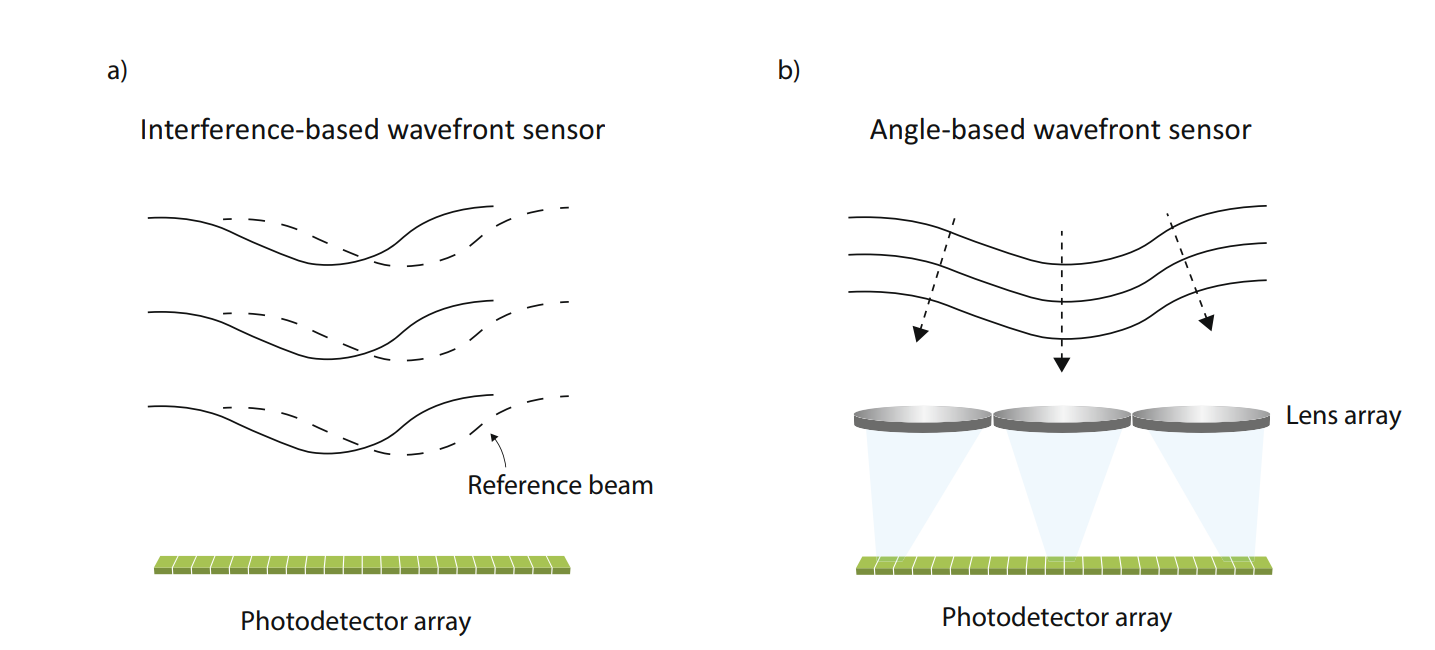
Image Credit: Yi, S. and Xiang, J., et al., (2021) Angle-based wavefront sensing enabled by the near fields of flat optics. Nature Communications, [online] 12(1). Available at: https://doi.org/10.1038/s41467-021-26169-z
Angle sensors have been used to measure wavefront for some time now, one of the most popular sensors being the Shack-Hartmann sensor. In contrast to other methods of wavefront sensing, the angle-based approach is used extensively in industrial applications and scientific research.
One of the main reasons for angle-based sensing having such a broad acceptance is because of its fully integrated setup, robustness and fast speed. However, one of the main drawbacks of the technology is its low spatial resolution, which is limited by the size of the angle sensor.
Angle-based Sensors
Angle-based Sensors use microlenses to sample the incident angles of light on a set of grid points. Once acquired, the values of angles are then added together and evaluated further to establish the wavefront of light waves.
These instruments are typically used in adaptive optics systems such as retinal imaging systems for the measurement of ocular aberrations, as well as finding applications in astronomy for wavefront sensing and correction.
However, as previously mentioned, the low spatial resolution holds these sensors back from being fully effective in demanding application scenarios such as quantitative phase imaging. This is because of the large lens size, and it is not as simple as reducing the lens size as the smaller a lens means a reduction in focus capabilities.
Flat-Optics
To overcome this challenge, the Wisconsin-Madison team applied an innovative technique based on flat optics to create a sensor with the potential to be used in quantitative phase imaging. Flat optics lenses are flat lenses that have the capacity to deliver distortion-free imaging due to their shape.
These lenses find application in holography, nanoantenna and on-chip optical processing. Typically, most flat optics rely on the far-field effect, but the Wisconsin-Madison team was interested in exploring the near-field effect of flat optics.
We use the energy distribution of optical field right after a flat optics component to measure the incident angle.
Zonfu Yu, lead author, and Associate Professor at the College of Engineering, University of Wisconsin-Madison
Fabrication & Development
The researchers used photolithography to define arrays of square patterns to fabricate the angle-based sensor. This method produces a sequence of square patterns on a negative tone photoresist layer of the complementary metal-oxide-semiconductor (CMOS sensor) – together with its four pixels, each square pattern produces one angle sensor.
What’s more, only one deposition and etching step is required for each of the sensors, meaning that it is possible to fully integrate into the existing CMOS sensor fabrication process. Therefore, these innovative angle-based sensors could be mass-produced at a low cost.
The novel angle-based sensors demonstrated enhanced spatial resolution and a wide dynamic range as a result of incorporating flat optic technology. The team was also able to adjust the near-field effect of the flat lenses to produce a sensor that can capture tiny measurements at 30 fps, which is a significant improvement on current angle-based sensing instruments.
We can significantly improve the quantum efficiency by improving the throughput of light. For example, one design is to use phase aperture instead of the binary aperture, which in principle can improve the light through over 90%.
Zonfu Yu, lead author, and Associate Professor at the College of Engineering, University of Wisconsin-Madison.
Enhanced Spatial Resolution
Overall, the main improvement of this new wavefront sensor is its high-resolution. This enhanced capability allows for angle-based sensors to perform quantitative phase imaging which is usually conducted by the interference-based method.
Although interference-based instruments, such as a laser interferometer, are vulnerable to mechanical noise or noise generated by a light source, they are still the dominant instrument for acquiring quantitative phase measurements.
However, Yu and his team hope that their newly developed sensors will serve as a complement to current interference-based methods. Innovative, high-performance angle-based sensors for rapid and high-resolution wavefront measurements provide exciting opportunities in adaptive optics as well as material characterization in manufacturing and life science research.
References and Further Reading
Yi, S. and Xiang, J., et al., (2021) Angle-based wavefront sensing enabled by the near fields of flat optics. Nature Communications, [online] 12(1). Available at: https://doi.org/10.1038/s41467-021-26169-z
Disclaimer: The views expressed here are those of the author expressed in their private capacity and do not necessarily represent the views of AZoM.com Limited T/A AZoNetwork the owner and operator of this website. This disclaimer forms part of the Terms and conditions of use of this website.